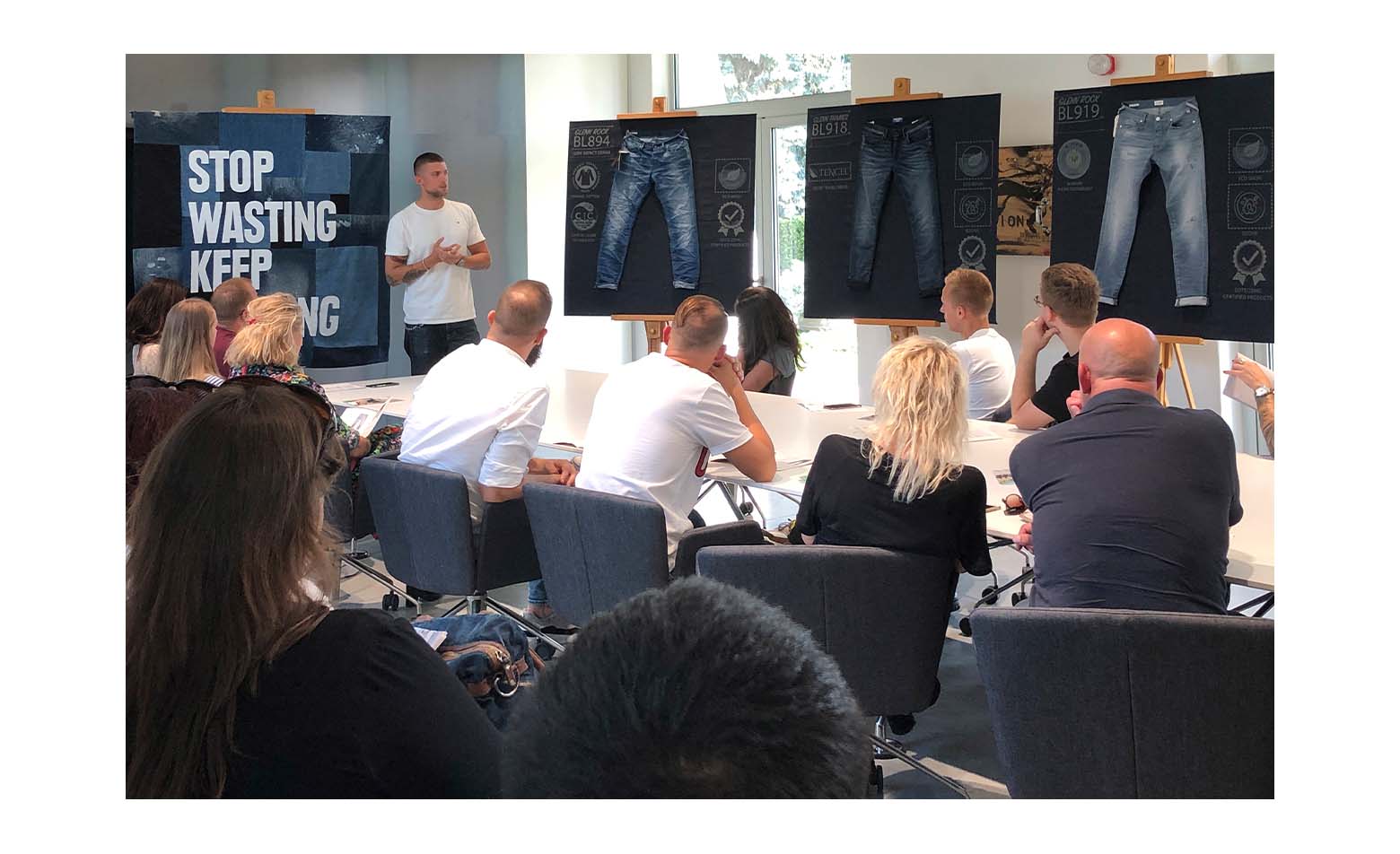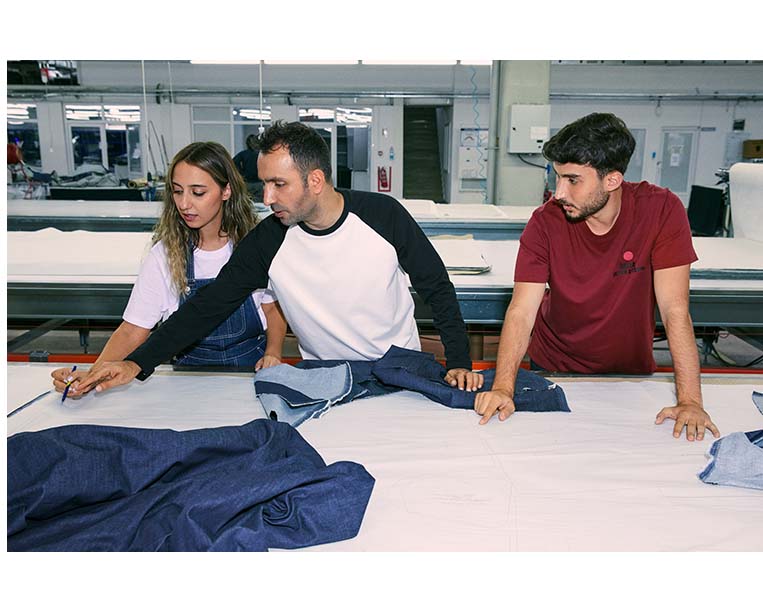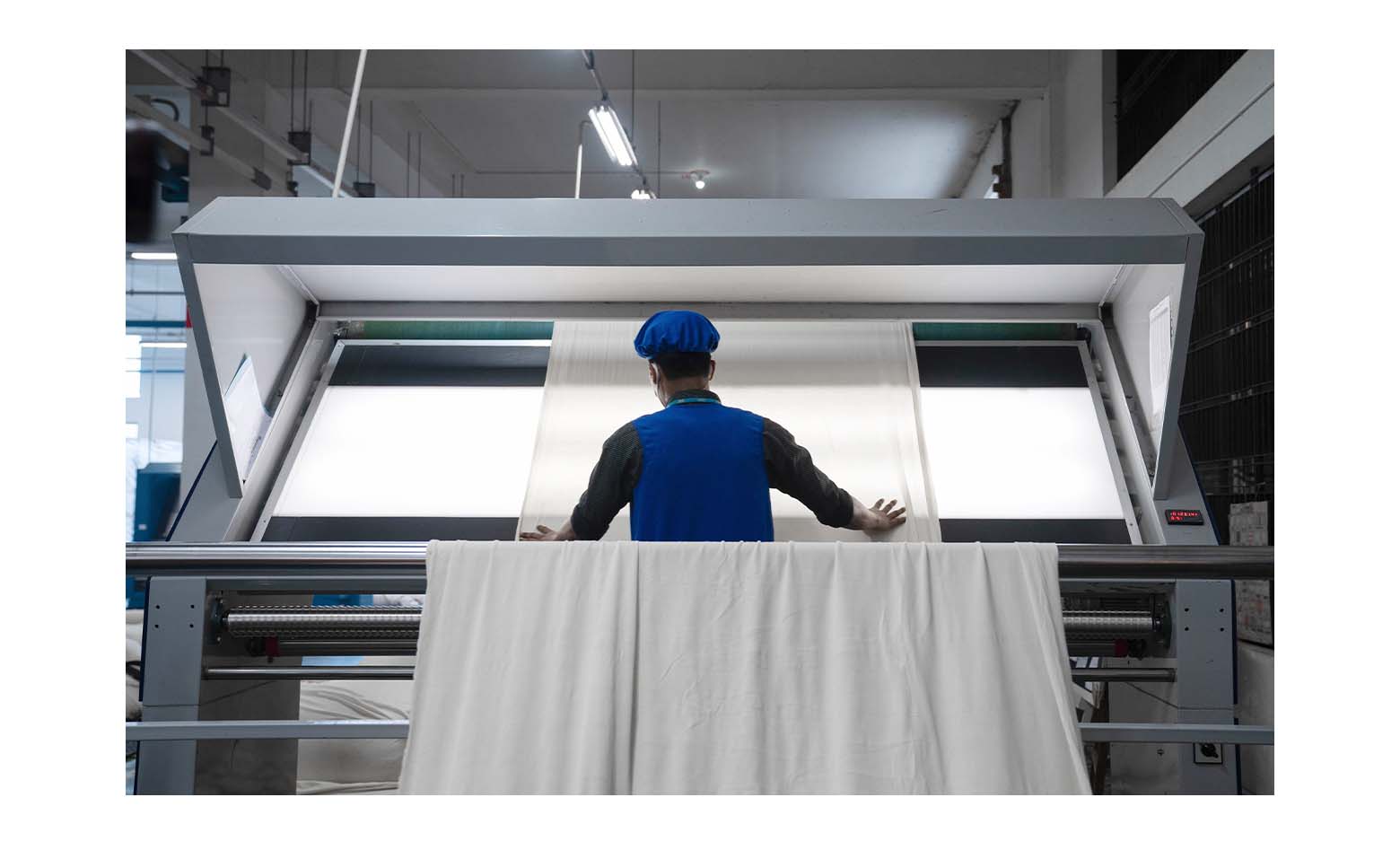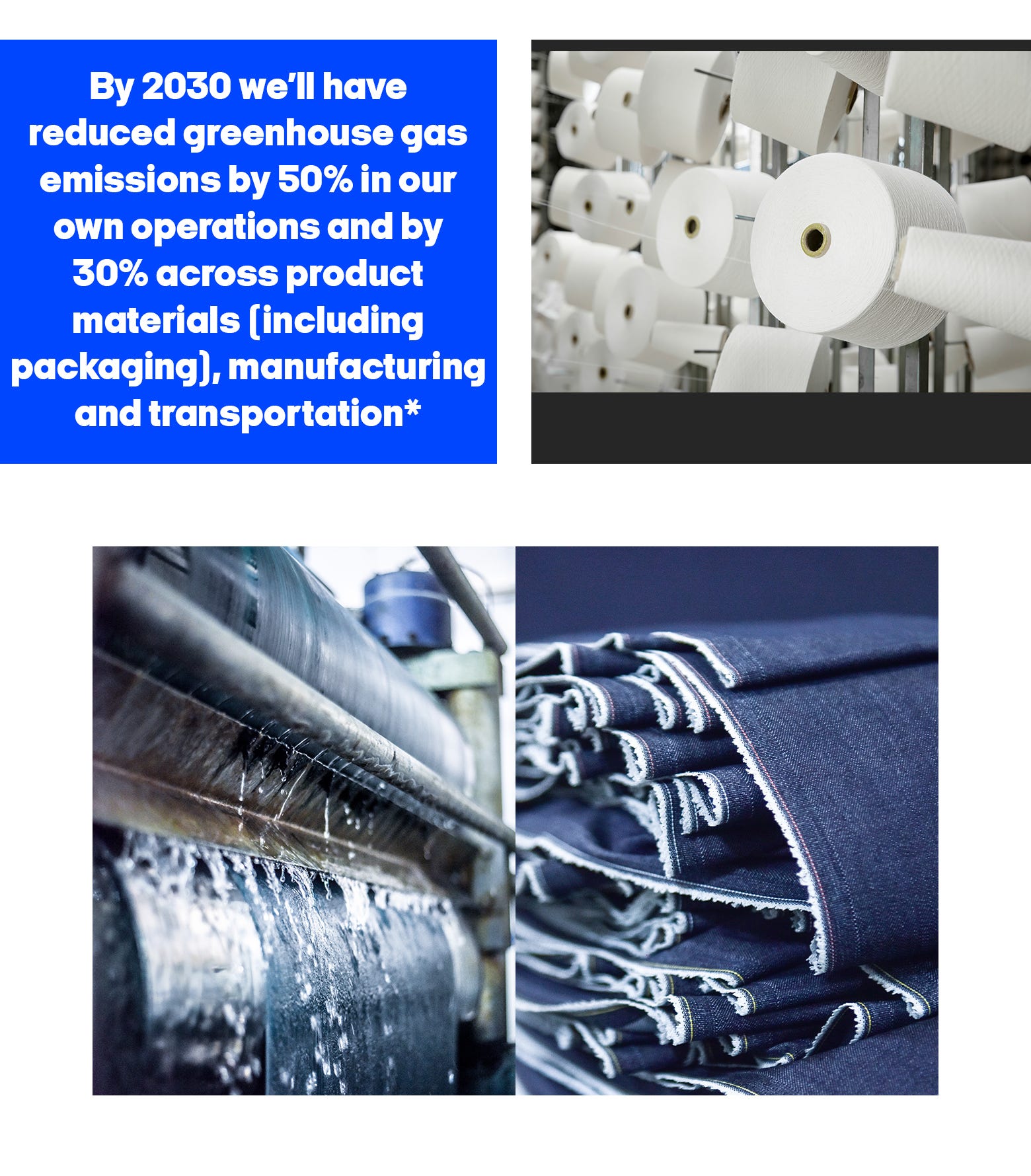
Proud to work with fashion’s most ambitious manufacturers
We are only as good as the manufacturers we work with and ours are as good as they come. Like us, they nerd out over material sourcing, how to lower the environmental impact of production and which innovations will keep us all moving forward. Like family, we challenge each other to do better, leaning on each other's expertise to solve problems and push what is possible, all while staying true to who we are and the values we stand for.
We believe this close relationship is pretty unique. We work shoulder-to-shoulder with a consolidated group of just 60 manufacturers, with a core group of 24 manufacturers producing 80% of our products. These manufacturers are true craftspeople, raising standards across the industry.
With the code of conduct, human rights policies, protocols and other checks-and-balances in place, we are doing the work to ensure our products are being made more ethically and responsibly.
But real progress happens in the space beyond compliance. Together with our manufacturers and parent company BESTSELLER, we invest in projects focused on elevating the people and communities contributing “behind the scenes”. Like the gender equality initiative RISE™, which as of early 2012 has provided health, financial management and workplace equality training to over 105,000 women across 56 factories of our manufacturers. (Status June 2024)
When it comes to our environmental impact, we are taking a close look at how we source, design and create our products. We have ambitious Science Based Targets (SBT) to reduce greenhouse gas emissions across our supply chain. We are also taking action to improve our water and chemical footprint, incorporating innovative dyeing and finishing processes into our collections.
Back at home, we have the JACK & JONES LAB: our own textile laboratory where we test the physical properties and parameters of our products like tear strength, button pull, snagging, pilling, bursting, color fastness, changes of surface and seam slippage. Why does that matter? Because wearing your clothes for longer is one of the most sustainable things you can do. Setting up The LAB is part of our commitment to work in collaboration with our manufacturers to ensure every garment we put onto the market lives up to our defining quality standards.

Raising the bar with the best manufacturers in the business
The best partnerships are like friendships: you hang with those you have a connection with, you build trust over time and you push each other to do things better. Since we started JACK & JONES we have partnered with, and continue to partner with, the industry's pioneers. We only work with manufacturers that meet our high social and environmental standards, and we have kept our manufacturer base purposely small so that we thereby give the security/commitment and willingness to invest in and develop more sustainable and socially-uplifting practices together.
From the start of JACK & JONES, we have had a strong system for assessing manufacturers on their social responsibility performance. This system allows us to not just measure how manufacturers are doing, but also to discuss improvements and take action.
Each factory
producing our products is given an internal rating based on how they perform in workplace health and safety as well as labor rights. All factories have to meet our minimum requirements, however ratings of bronze (good), silver (better), gold (even better) and platinum (exceptional) show us that the factory is going above and beyond.
Our rating system is under constant development, to give our customers more information on how our products are produced as well as to support our goal to drive improvements in the supply chain.
How does a manufacturer get to work with JACK & JONES? Well, it is not easy! BESTSELLER’s Sustainability Report goes into the details, but here is a quick summary:
First, new manufacturers have to pass a comprehensive onsite inspection to ensure they meet BESTSELLER’s Basic Requirements across labor, social, chemical and environmental performance.
Then, manufacturers conduct routine self-assessments across 16 areas including child labor, employee treatment, wages and benefits, health and safety, environment, and waste-water management through our Factory Standards Program.
The self-assessment is then verified during an on-site visit in all our tier 1 factories, including outsourced supporting units and tier 2 tanneries by our in-country teams or third-party auditors. The factories are given a rating for social and labor as well as for environmental performance. For the environmental performance our local Chemical & Environment teams monitor water, energy, chemical and waste-water management. If one of our manufacturers falls below our standards, we have defined escalation protocols. Corrective Action Plans summaries the assessment findings and the remediation plan and timeline.
One of the things that we think differentiates our relationship with our manufacturing partners is the trust and loyalty we have built up over the years. 80% of our products are made by a core group of 24 manufacturers, some of which we have worked with for over 20 years, and we only work with about 60 garment manufacturers across all product categories in any given year.
Many of these manufacturers have long-standing social and environmental programs that are uniquely designed to meet the needs of their employees and communities — like generating on-site solar energy, providing free daycare and funding local development projects. You can learn more about these initiatives from the people who are driving them forward here.



Partnering up to make an even bigger impact
To make real change, we have got to look at the whole picture. Ethical trading, worker health and safety, fair wages, worker empowerment, environmental impact — these are just some of the areas where we are pulling up our denim-shirt sleeves and doing the work. But we cannot do it alone. Alongside our manufacturers and our parent company BESTSELLER, we are involved in a number of high-impact programs and initiatives focused on improving the apparel sector overall.
Worker health and safety. Since 2013, we have been part of the Accord on
Fire and Building Safety In Bangladesh, a landmark, legally-binding agreement signed by over 200 fashion houses around the world to improve worker safety in factories across the country. In 2021, we signed an updated agreement called the International Accord for Health and Safety in the Textile and Garment Industry, which remains legally-binding and upholds the commitments made as part of the original Accord. All of our manufacturers in Bangladesh are covered by the Accord, meaning factories are regularly inspected, safety training is given to employees and corrective plans are issued to resolve any fire, electrical or building safety issues. We do not onboard any manufacturer that is unwilling to participate in the inspections, remediation and workplace programs.
Fair wages and ethical trading. Through BESTSELLER, we are part of the Action Collaboration Transformation (ACT) since 2018, an agreement between 21 major fashion brands and IndustriALL Global Union to work together to make purchasing practices and negotiations on working conditions and living wages transparent and fair. We have also been a partner of the Ethical Trading Initiative, a leading alliance of companies, trade unions and NGOs that promotes respect for workers' rights around the globe, since 2016.
Worker empowerment. Since 2012, we have collaborated with RISE™, a program that is focused on improving health education for women in the workplace and provides training in financial management and workplace equality for women and men. In January 2023, the RISE™ initiative training has positively impacted in total 105.000 workers across 56 factories of JACK & JONES’ manufacturers in Bangladesh, Pakistan, China, India and Myanmar. In 2019, our parent company BESTSELLER committed to a five-year strategic partnership with the organization behind RISE™, Business for Social Responsibility, which means that we have been able to step up our involvement and become more hands-on with developing new empowerment programs. You can learn more about the impact of the RISE™ partnership here.
Social and environmental responsibility across the board. Since 2013, we have been a member of the Sustainable Apparel Coalition, a not-for-profit organization working to reduce the environmental and social impacts of apparel and footwear products around the world. We have adopted a number of their tools, including the Higg Facility Environmental Module (Higg FEM). This tool measures and tracks sustainability performance at our manufacturers so we can work toward improvements together. It assesses seven areas of impact: environmental management systems, water use, wastewater, chemical use, waste management, energy use and greenhouse gas emissions. So far, across all BESTSELLER brands, 219 manufacturers have completed the Higg FEM assessment, representing 86% of the group’s supply chain.
On the path to reduce our climate impact with our manufacturers (and beyond)
There is no getting away from it, making clothes requires the use of natural resources, which impacts climate change. Being a key player in the industry, we recognize that we have a role to play. We have been working closely with our manufacturers to rethink how we design and create products to minimize our climate impact — from standardizing fits to using automated machinery, cutting down energy use to switching to renewable power. It is all in service of our ambitious Science Based Targets (SBT) to reduce greenhouse gas emissions across our supply chain.
In 2021, our parent company BESTSELLER’s commitments to reduce GHG emissions were approved by the Science Based Targets Initiative (SBTi). This organization
assesses whether the actions laid out will meet targets set by the Paris Agreement (a legally binding, international treaty on climate change). BESTSELLER’s SBTs have now been approved as aligned with a 1.5°C pathway, the most ambitious goal of the Paris Agreement.
In 2021, we have reduced our absolute scope 1 and 2 GHG emissions by 82% (compared to a base year of 2018). This includes emissions from electricity, heating and vehicle use.
By 2030, we will have reduced absolute scope 3 GHG emissions from purchased goods and services and upstream and downstream transportation by 30% within the same timeframe. That includes emissions from raw materials, yarn and fabric production, garment manufacturing, transport, packaging, use of sold product and product end-of-life.
Working with our manufacturers to achieve these targets is vital. We use the Sustainable Apparel Coalition’s Higg Facility Environmental Module (Higg FEM) to measure and track sustainability performance so we can work toward improvements together. It assesses seven areas of impact: environmental management systems, water use, wastewater, chemical use, waste management, energy use and greenhouse gas emissions.
We also know there is a lot we can do on our end to make production more efficient, and therefore less energy-intensive. We are supporting our manufacturers’ transition to automated machinery and high lean manufacturing, which allows them to reduce their material waste and energy use while ensuring a consistent level of quality. We have created product-specific Tool Boxes and we are limiting small differences between items so that production is standardized (and lower waste).
Like with workers’ rights and empowerment, partnership is key when it comes to climate. In China, we cooperate with the Institute of Public Affairs (IPE) a non-profit environmental research organization which monitors different aspects of environmental supply chain management (such as energy use, wastewater, air emissions and waste) and records factories’ performance on a public database, letting us (and the public) know about any issues we need to act on.
Together with our parent company Bestseller we have launched the FWD>ENV initiative in February 2021, a first-of-its-kind two-year cleaner production and capacity building program for manufacturers in Bangladesh to help lower the impact of their facilities over time (learn more about it in BESTSELLER’s Sustainability Report). 120 supplier representatives have taking part across the various sessions in 2021.
These are the actions we are taking toward manufacturing, but our commitment to climate action goes well beyond that. Check out our materials page to learn about our transition to organic, recycled and certified fibers and our retail page to learn more about efforts across our operations (including building our very own solar plant).

Reducing our water and chemical footprint
Water and chemicals feature heavily in the production of clothes — traditionally, that is. From water use to dyes and finishes, what goes into clothes can also come out, having a big effect on the environment. Here at JACK & JONES, we take this seriously. Since launching our Low Impact Denim concept in 2012, we have been continuously evolving and improving our processes, teaming up with cutting-edge companies like Jeanologia who are helping to disrupt the industry with their high performance production methods. By partnering with them to push what is possible — and doing it at scale — we are continuing to challenge not only ourselves but the industry to do better.
Through BESTSELLER, we are a member of the Alliance for Water Stewardship. We believe that water is a shared
responsibility and see the need of a collective response to the challenges of our water resources. Water Stewardship enables us to work together with all stakeholders to identify and achieve goals for water management. We have developed a comprehensive water framework which identifies key impact areas and outlines actions we have to take towards structured water stewardship practices. We focus on sourcing certified materials that involve more efficient water use during the production. Further we cooperate with manufacturers to promote more responsible water management. Our membership of the Fashion Pact enables us to support our overall ambitions regarding water. A vital part of the strategy is innovation. We focus on sourcing more innovative materials and work shoulder to shoulder with our manufacturers on new solutions in production processes. In the future we will also engage in innovative solutions in the use phase of the product.
Diving into our water use: Our Low Impact Denim concept is where we get most innovative. We use DyStar Liquid Indigo Vat 40% Solution and special dye accelerators to reduce water use in the dye process. Of the water that is used, at least 85% is recycled and wastewater is treated in a closed-loop system, which is safer for workers and the environment.
Across our LID styles, water-saving processes include the use of:
● DyStar Liquid Indigo Vat 40% Solution reduces the amount of water needed for preparation and removes the need for reducing agent. This results in up to 70% reduction in hydrosulphite/ caustic soda und therefore cleaner wastewater.
● ‘Dyeing’ concepts such as ‘Crystal-Clear’ from Artistic Milliners, ‘Waterless’ from DNM, ‘D-Clear’ or ‘Dyepro’ from Calik and ‘Save’ from Bossa. During the dyeing method Dyepro no water is used and no chemical waste generated.
● We work with the newest available technologies for impactfull finishing treatmetns such as ozone, e-flow and laser treatments. Jeanologia’s e-Flow washing technology saves water by using nanobubbles of air (instead of water baths) to achieve the authentic jeans look we all love.
On the chemical side of things: By 2025, all of our core products will be made using approved and traceable chemicals. Right now, we manage chemical risk on two levels. We have a thorough and continuous chemical testing program to ensure that our products meet the standards laid out BESTSELLER’s Restricted Substances List. Our trims are also produced in line with these standards, by suppliers who meet (and exceed) our high-level quality and safety standards. We test products on a continuous and yearly basis to safeguard that chemicals are not in our clothes and that the testing program is working across all tiers down in our supply chain. On a second level, we work closely with our suppliers to ensure they have a safe and well-managed inventory. Manufacturers need to have protocols in place for the safe handling of chemicals and provide us with a chemical inventory list of the chemicals kept on site. Further, safety precautions in regards to use, storage and handling of chemicals must be followed.
Our membership with the Apparel and Footwear International RSL Management (AFIRM) Group means we are aligned with industry standards on restricted substances and kept up to speed with any new legislation. We are also improving manufacturer transparency by encouraging the use of tools like BHive which enables factories to cross-check chemicals in real-time via an app. As part of the environmental rating the Bhive app is one way for manufacturers to demonstrate compliance with our RSL and transparency on chemical inventory.
And, with state-of-the-art finishing experts Jeanologia, we are actively working on new technologies to replace chemically-intensive treatments such as stonewash and conventional bleach with alternative treatments. For instance, their G2 technology achieves the faded look by turning air into ozone to react to the dye. Pretty neat, and there is more on the way.
Going above and beyond to make clothes that last
We have a comprehensive testing system for all JACK & JONES products in The LAB, our very own textile laboratory. That is because wearing what you already own and keeping your clothes for as long as possible is one (big) way to minimize your (and our) impact on the environment. Home to experts with the skills and knowledge to test production and performance, The LAB assesses every aspect of your clothes, bringing in manufacturers, buyers and partners to continuously innovate and improve — no cheap, fast-and-easy routes here. Because for us, durability is what JACK & JONES is all about.
The LAB is located at our HQ in Brande, Denmark. There are
also nine manufacturers with in-house facilities that have been awarded our LAB Certification, which allows them to undertake their own testing. Manufacturers without a JACK & JONES-approved LAB use third-party testing facilities.
In our LAB we test qualities like tear strength, snagging, pilling (the fuzz that can form on clothing), bursting, color fastness, changes of surface and seam slippage. We make sure to test performance not just once but over three, five and 10 washes to measure how well products hold up over time.
If a product does not meet our requirements, test results are shared with buyers and manufacturers along with recommendations on where and how to improve. For example, we might ask a partner to investigate a different type of seam construction to avoid the seam slipping.
By doing the work upfront, The LAB gives us the opportunity to continuously improve our products and is just one more way we are making sure our clothes are durable so they can stay in use for as long as possible. You can learn more about The LAB here.
